The versatility of a shotgun cannot be matched by many other types of firearms. You can select from a wide variety of gauges, barrel lengths, chokes, shot sizes, and more. This allows a shooter to utilize a shotgun for a multitude of purposes like hunting, home defense, and sporting clays.
However, all the different varieties and purposes can be overwhelming to new shotgun owners. Instead of covering every potential shotgun variation, it’s best to focus on the biggest question new shooters have, “Which gauge works best for me?”
Most prospective shotgun owners will narrow their choices down to two options: 12 vs 20 gauge.
The 12-gauge shotgun is the most effective one-gun solution for hunting, target shooting, and home defense. However, that doesn’t mean that the 12-gauge is the best choice for every situation.
In this article we will analyze the advantages and disadvantages of the two most popular shotgun options, 12 and 20-gauge.
What’s the Difference Between 12 Gauge vs 20 Gauge?
The difference between 12 and 20-gauge shotguns is their bore diameter. A 12 gauge has a bore diameter of 0.729” compared to 0.615” for 20 gauge. This means that a 12 gauge can fire larger payloads of buckshot at higher muzzle velocity at the cost of higher felt recoil.
12 Gauge vs 20 Gauge: Understanding Shotgun Gauges
If you’re familiar with shotguns, you’ll know that a lower gauge means a bigger caliber. However, if you’re new to shotguns or firearms in general, this can be a confusing concept to grasp.
Handgun and rifle calibers are defined by their internal bore diameter. A 40-caliber handgun has 0.40 inch diameter bore. This means the bigger the number, the bigger the bullet the gun can fire. However, shotgun gauges are determined by a more archaic system.
Gauge is determined by the number of lead balls with the same diameter as the barrel would add up to one pound.
For a 12-gauge shotgun with a bore diameter of 0.729” it would require twelve lead balls to equal one pound. Likewise, for 20 gauge guns, it requires 20 lead balls with a 0.615 inch diameter to equal one pound.
A Special Note On 20-Gauge Shells: Yellow is the New Black
If you’re new to shotguns you might not be aware that all 20-gauge shotgun shells are required to be colored yellow, regardless of payload.
This is to endure that a shooter does not mistakenly load a 20-gauge shell into a 12-gauge shotgun. If this were to happen, it’s possible that a 12-gauge shell loaded behind could cause the 20-gauge shell to fire inside the magazine causing catastrophic damage to the firearm and potentially the shooter.
For this reason, it has been mandated that all 20-guage shells are colored yellow to make them easily distinguishable from 12-guage shells.
Recoil

When it comes to felt recoil, 20-gauge shells win by a country mile. As 12 gauge shells pack a heavier payload of projectiles and powder they will always have more recoil than comparative 20 gauge ammo. This chart compares the felt recoil experienced by the shooter for three popular 12 and 20 gauge Winchester SXP hunting loads.
Less recoil gives a 20-gauge shotgun two distinct advantages.
The first advantage is the comfort factor to the shooter. Although felt recoil will be different between shooters, the low recoil impulse that the 20-gauge shells impart on its user’s shoulder often results in increased accuracy. Less recoil means that it is less likely for a shooter to develop a flinch or raise their head off the stock just prior to firing.
The second advantage is speed of follow-up shots. Regardless of whether you need to line up two quick shots on a pheasant you just kicked up or if you need to perform a mag dump in a self-defense situation, the lighter recoil of the 20 gauge makes this an easier task.
Accuracy/Pattern Density
To understand pattern density, it’s important to understand how a shotgun ammunition works.
A shotgun shell, or shotshell, is a plastic hull with a primer at the bottom. Inside the hull is a powder charge and on top of that is a plastic cup known as a “wad” to hold the projectiles known as “shot” which are essentially just round steel or lead balls.
Shot sizes will vary depending on what you’re planning on using the shotgun shell for. For self-defense you would want to use something larger like #00 buckshot (pronounced “double aught”), or if you’re hunting something smaller, like grouse or pheasant, a smaller option like #8 birdshot would be ideal.
One common misconception is that once the wad and buckshot leave the shotgun barrel, it behaves like a swarm of bees and scatters quickly. However, what happens is that the shot leaves the barrel in a column and begins to disperse.

There are numerous factors that affect how the projectiles disperse, such as minor imperfections on the surface of the shot, muzzle velocity, and stringing.
Stringing is a process where the shot at the top of the wad is deformed less during firing, while shot at the bottom of the wad endures the added pressure and weight of all the shot above it causing it to deform. This means that the buckshot at the top of the column will reach the target faster (because it’s more aerodynamic) than the shot at the bottom of the column.
The width of dispersion of shot when it reaches the target is referred to as pattern density. If the patter density is too wide, it’s possible to miss a smaller bird like a quail, at range. Conversely, if the pattern density is too tight it will be harder for shooters to score hits.
One other factor that can affect pattern density is the type of choke used in the shotgun barrel. A choke typically screws into the barrel and acts like a forcing cone, making the lead or steel shot a more compact column as they exit the barrel. Chokes will create a tighter pattern density but should not be used with slugs.
As the 12 gauge has a wider bore diameter, it can fit more shot into a wad. This means that it will have a higher pattern density than 20 gauge shot.
Stopping Power
The 12 gauge shotgun has been well known for its stopping power due to its effectiveness in trench warfare during WWI and in the jungles of the Pacific theatre during WWII. Furthermore, the 12 gauge Remington 870 pump-action shotgun is a favorite of law enforcement and can be found in squad cars across the United States.
There’s no denying that a 12 gauge load packs a huge punch, but how much? In the table below we compare three popular loads for both 12 gauge and 20-gauge shells.
Let’s compare the rifled slugs for the purpose of this explanation.
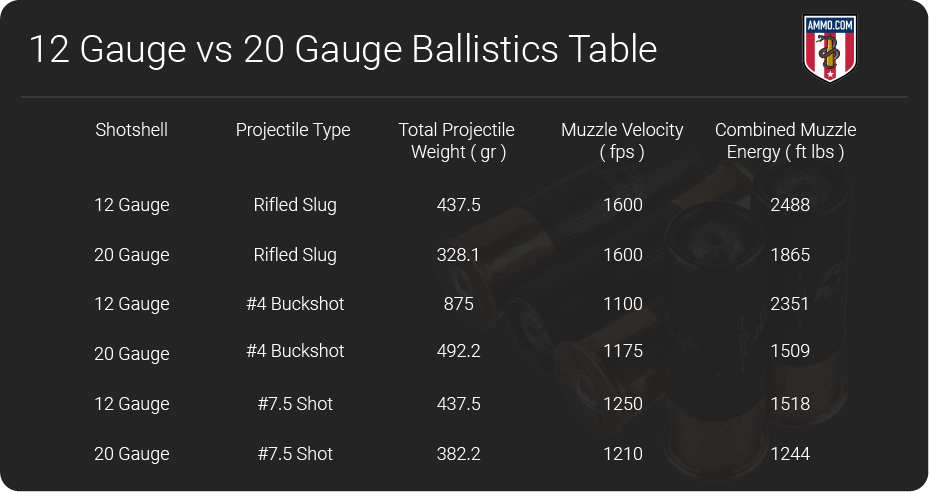
Even though both slugs exit the barrel with the same muzzle velocity of 1600 FPS, the 12 gauge load has a muzzle energy of 2488 foot-pounds while the 20 gauge load clocks in at 1865 foot-pounds (that’s a 33% difference!)
Although the disparity will vary between different loadings, 12 gauge shotgun ammunition will generally always have more stopping power than a comparative 20 gauge load.
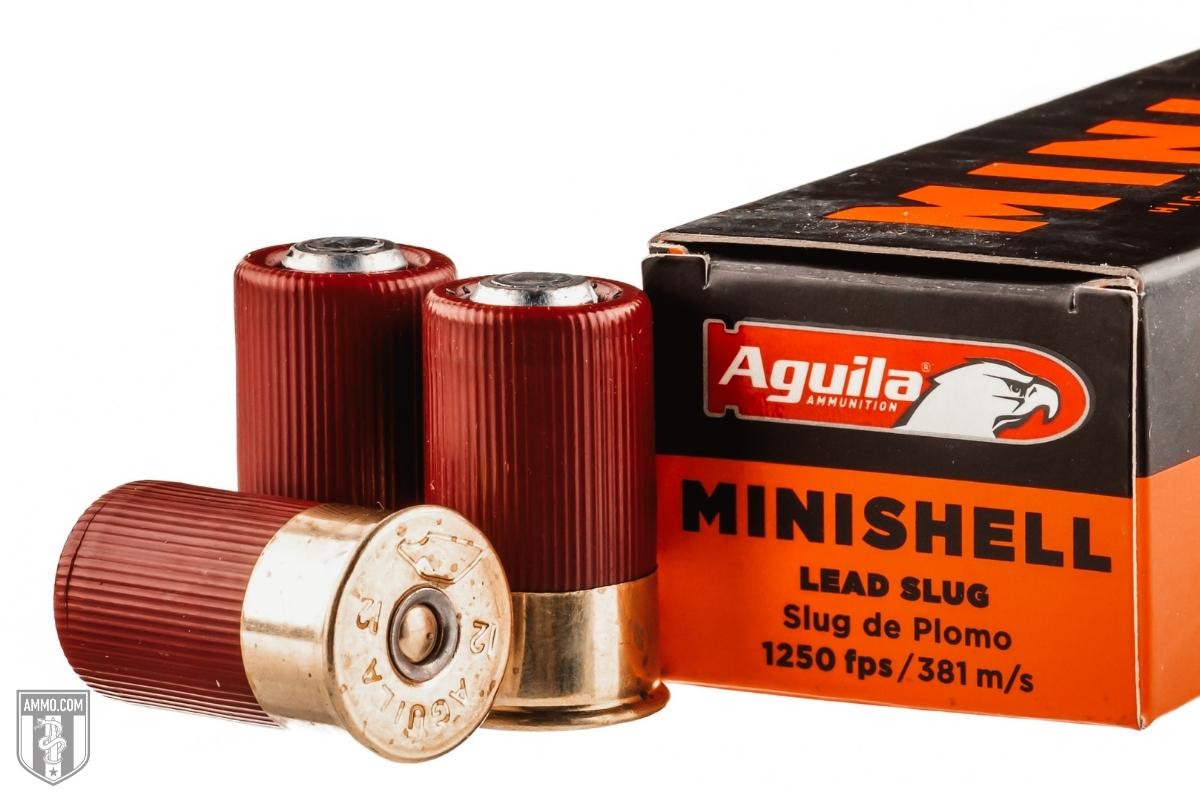
Hunting
When it comes to getting into the woods for some hunting, you’ll find plenty of 12 and 20-gauge shotgun shooters in their tree stands or deer blinds in the fall.
Both shotgun gauges are extremely popular for hunting all types of game animals from upland bird, waterfowl, turkey, and even whitetail deer.
Proponents of the 20-gauge shotgun will cite its recoil advantage over the 12 gauge and suggest that it is more than sufficient for all sizes of game. On the other hand, 12-gauge aficionados will bring up the shotshell’s hard-hitting terminal ballistics and extended range that the 12 gauge offers.
Although 20-gauge loads can be effective for turkey hunting, waterfowl, and deer, the major issue is that you need to be at close range. As the 20 gauge shotshell has a lower muzzle velocity compared to the 12 gauge, the 20 will lose velocity faster and how a shorter effective range.
Therefore, the majority of hunters will grab their 12-gauge shotgun when they plan to hunt larger game animals like duck, goose, turkey, and deer. The extended range and stopping power more than make up for the additional felt recoil in most cases.
However, for small game or bird hunting, the 20-gauge is usually the best option. With its low recoil, it allows manufactures to produce a lighter gun that is quick and maneuverable. This makes it easier for hunters to quickly bring their gun to bear on a grouse or pheasant they kicked up. Furthermore, the lower recoil of the 20-gauge allows for extremely quick and accurate follow-up shots.
There’s absolutely no reason why you can’t bring your 12-gauge shotgun bird hunting as they are extremely effective. Although, if given the choice, most game hunters will opt for the lighter gun, and that’s most often a 20-gauge.
If you can only purchase one shotgun, then the 12-gauge is the best option as it does it all.

However, if you have the financial capability to purchase both, a 20-gauge shotgun is an excellent choice for small game while you can still employ your 12-gauge medium to large game hunting.
Self-Defense/Home Defense
When it comes to home defense, it’s hard to be a shotgun. Although some shooters contest that a handgun is the better choice, it simply does not compare to the sheer power that a shotgun offers.
For home defense, it is inadvisable to use rifled slugs as they will typically over penetrate and could hit an innocent bystander in the home or apartment next door. Buckshot is what you want loaded in your self-defense shotgun.
There is some scholarly debate amongst ballisticians as to which buckshot is the best option for home defense. Many swear by #00 buckshot as it is considered the gold standard for self-defense, however other state that #1 or #2 buckshot is more than sufficient for any home defense situation.
If you’re unfamiliar with buckshot designations, here is a chart explaining the difference.
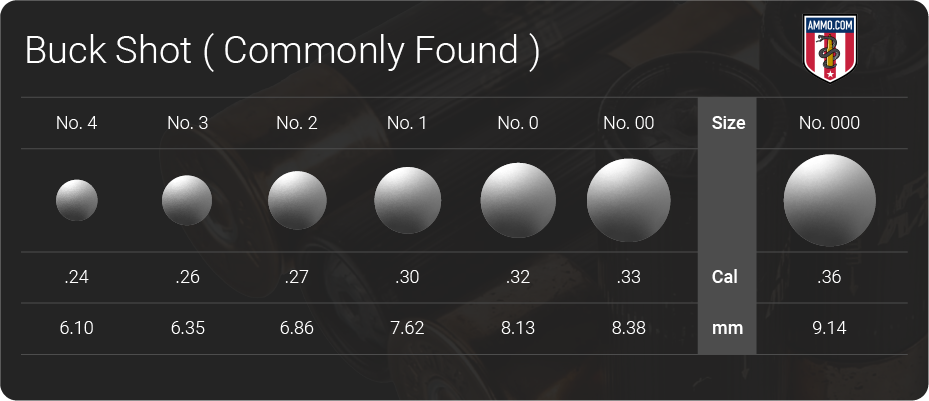
As you can see, the difference between #00 buckshot vs #1 buckshot is 0.03” in projectile diameter. This debate has been beaten to death on the Internet, however the bottom line is that any would-be home invader will likely not be able to tell the difference.
But that brings us to which shotgun would be better for home defense? 12 vs 20 gauge?
Many shooters like the feel of a 12-gauge shotgun for home defense. It’s what the military and police use and for some people, that’s all they need to know. Others like the lower recoil of 20-gauge shells and feel they are more accurate with this ammo.
For close range engagements like those in a home, it won’t make much difference which shotgun you choose. Both will be more than effective in defending your life and the lives of your friends and/or family members.

Just make sure to load up with a quality buckshot (NOT birdshot or slugs) and you should be more than adequately prepared to take on any threat that enters your home and threatens your life.
Ammo and Rifle Cost/Availability
The beautiful thing about shotguns is their versatility. You have so many options, from a single shot, pump action, and even a semi-auto, the world is your oyster when it comes to shotguns.
Furthermore, entry level pump action models are typically inexpensive compared to most centerfire rifles and handguns. You can easily pick up a Remington 870 or Mossberg 500 for around $300 new in box at the time of writing.
However, this does not mean that all shotguns are so affordable. If you’re looking to get into sporting clays, skeet, or trap shooting, most competition-ready shotguns will command several thousand dollars.
Although a 20-gauge shotgun typically requires less materials to produce, there is very little difference in price between 12 and 20-gauge shotguns.
As for variety, you will not lack for options for either gauge. However, there are going to be more options for the 12-gauge as it is the most popular gauge in North America due to its versatility.
The same is true for ammo cost. Although the 20-gauge shells are smaller and require less material for construction, there is very little difference in cost between 12 vs 20 gauge.
Just like for rifle variety, you will find more options when you are purchasing 12-gauge shells as they are the most popular. There are still plenty of options for 20-gauge ammunition, just less than 12 gauge.
Buying in bulk is always smart, make sure to check out our stock of bulk 12 gauge ammo.
Reloading

Reloading shotgun shells is something that many reloaders enjoy doing. However, as shotshells are relatively inexpensive, most reloaders do not bother reloading used hulls.
The cost savings for reloading shotgun shells is so low that only high-volume shooters ever worry about doing it, as it is usually cheaper just to buy new factory shotgun ammo. However, if you love the idea of optimizing your shotgun ammo, there’s nothing stopping you for loading your own shotshells.
Please note that shotshell reloading requires a specialized press that cannot be used for centerfire rifle and handgun reloading.
A Brief History of The Shotgun Shell
In their infancy, most firearms could fire a single projectile or multiple as they all had a smooth bore. Early firearms like those used by the settlers of the New World needed this versatility to survive by hunting small birds to deer with the same gun.
However, with the introducing of rifling during the mid-16th Century, rifles and shotguns became two separate entities with different purposes.
At this time, shotguns were mostly used for bird hunting but also saw use in law enforcement and protection details.
Did you ever “call shotgun” as a kid when getting into a car? This phrase dates back to the Wild West when the person sitting next to a stagecoach driver would carry a shotgun to protect the cargo or passengers from outlaws.
The first shotgun shell was introduced by the French gunsmith, Casimir Lefaucheux, in 1836. Most early shotgun shells were made entirely of brass as paper cartridges were unreliable and couldn’t be reloaded.
It wasn’t until 1960 when Remington introduced the plastic shotgun hull that is used today.
Final Shots: 12 Gauge vs 20 Gauge
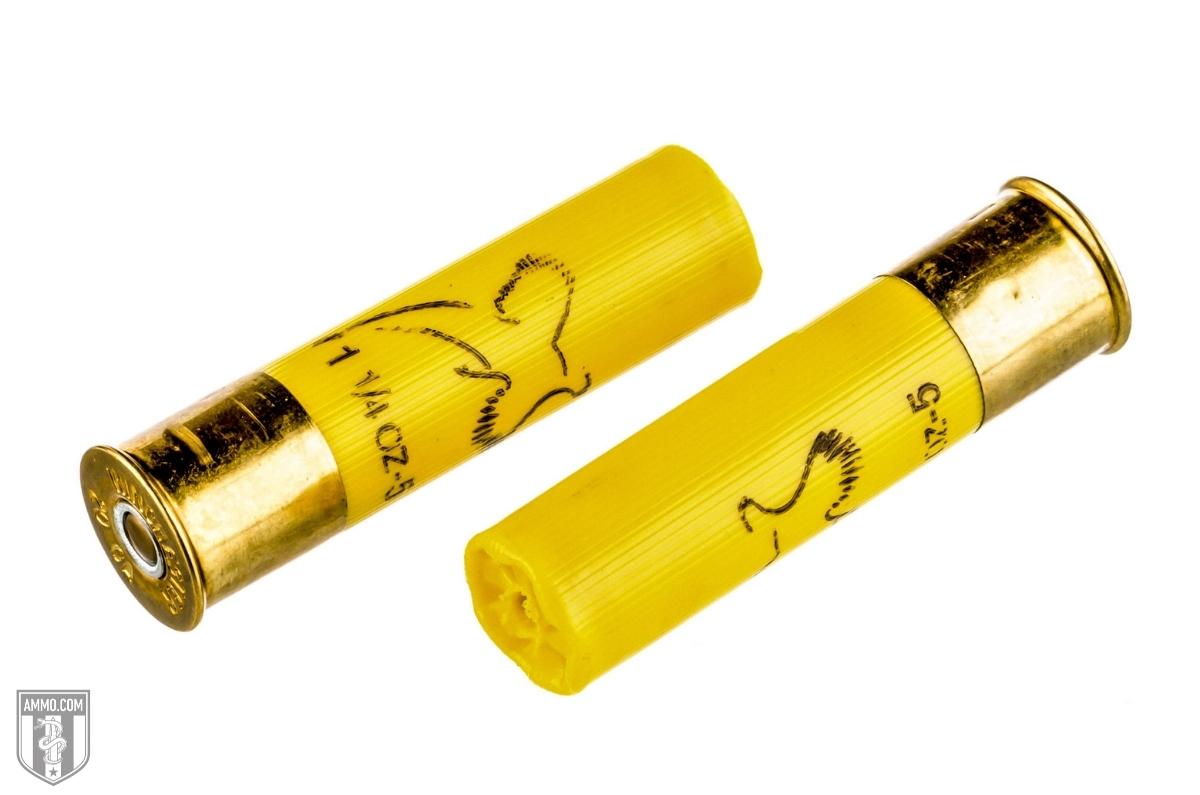
There’s no denying that the 12 gauge is the “jack of all trades” option in the shotgun world. There plenty of target load options for sporting clays, trap, and skeet, heavy slugs for deer, and a variety of birdshot for turkey, waterfowl, and upland birds.
Not only is the 12 gauge a potent option for all forms of hunting, it is an extremely effective home defense option when loaded with quality buckshot shotshells.
However, just because the 12-gauge can do it all, that doesn’t mean that it’s always the best option.
The 20-gauge shotgun has proven itself to be a capable upland bird gun as it is fast, maneuverable, easy to carry, and packs enough punch to fell pheasants, grouse, and doves without issue. At close range, it can also be utilized for turkey, deer, and self-defense with proper loads. And it can do all of these things with approximately 33% less recoil than a 12 gauge.
Which shotgun gauge is best for you depends on your personal needs as a shooter. If you are recoil sensitive and only plan to hunt upland birds then the 20-gauge shotgun will be everything you need it to be.
The ideal choice would be to own both, however if you are on a budget then the 12-gauge shotgun is the best option as it does everything you could possibly want at a very reasonable price point.
12 Gauge vs 20 Gauge: The Shotgun Shootout originally appeared in The Resistance Library at Ammo.com.


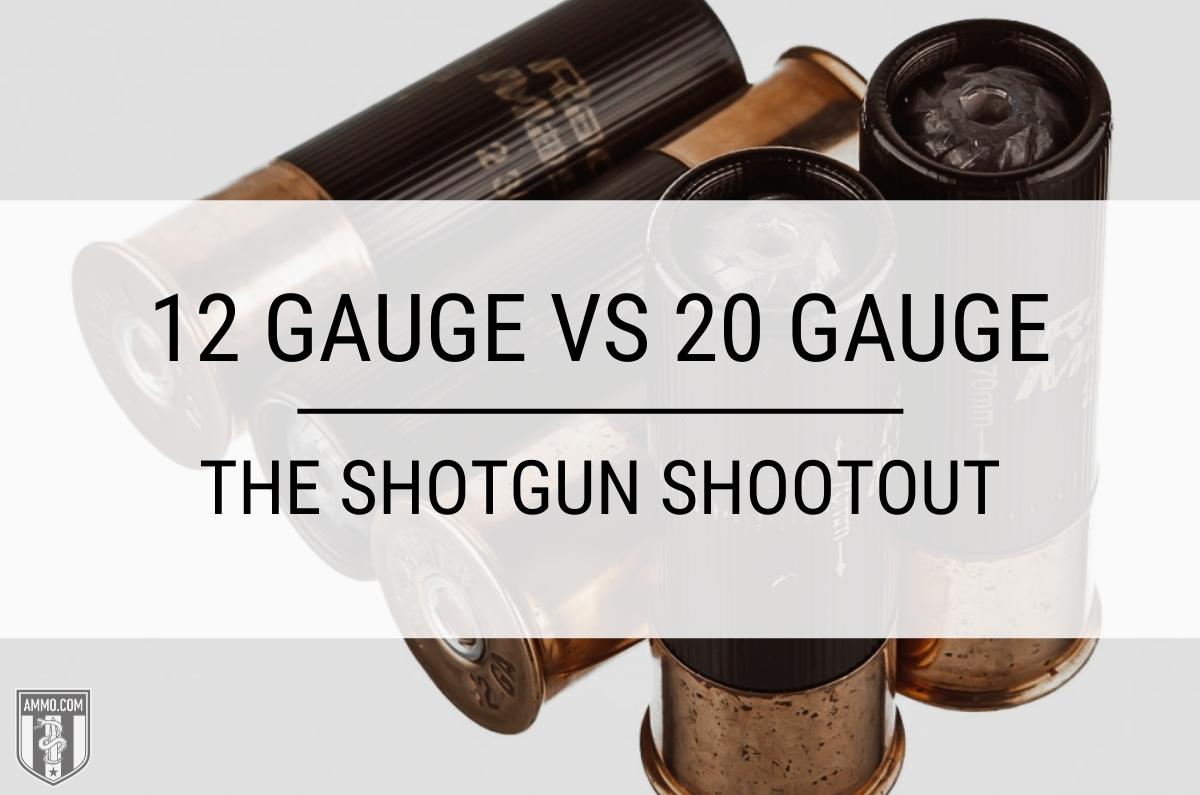



My petite wife can handle a 20 gauge with a pistol grip…so there is that…would never put a 12 gauge in her hands.
She was amazed at the hits in the man sized target the first time I snapped her in on it.
The look on her face was priceless! Now she gets it!
My 20 gauge Shockwave can lay across my back in a sling with the two handed weapon of my choice in ready…and the hand gun(s) of my choice strapped on.
I have a 12 gauge Mossberg 500 I bought in 1983 that to this day delivers.
Have other modern day 12 gauges (Dam those John Wick cartoon movies…have cost me a lot of $$$$) but the old Mossberg is close to the bed.
I own shotguns in every gauge except 10.
I shoot a beautiful best gun 16 for everything
except wildfowl and intruders. 12 for that.
I’m a man and I don’t notice any recoil in a 12g, and a 20g is like 22. As for 00 for home defense, that is a big round in my opinion inside a building; some will even go through a person and through several walls; I killed a large animal once at about 75 ft with #7 birdshot in a Mossberg 500 (I was hunting squirrels), although it ran about 20 ft before falling over dead. I’d recommend about a 38″ gun loaded with a BB, a 00, and a slug for home defense.
…mama
Mossberg 590A1 12 ga. 8+1 for home defense and killing poisonous snakes.
Agree with using #1, #0 to reduce penetration.
home defense and killing poisonous snakes but you repeat yourself.
Mossburg 500AG 5+1, 3″ mag, #000 B, Select Choke cranked to full with a pipe wrench.
The Army Corps of Engineers that manages the lake near me allows permitted hog hunting on ACE lands, but require shotguns and slugs.
To fulfill this requirement, I bought a rifled barrel for my 20ga 870 and had a gunsmith put a scope mount on it.
I have yet to miss a humane shot using sabot rounds thru it, though I admit most shots were withing 75 yards.
Went bird hunting with 6 buds in the Dakota’s, and I knew we’d be walking all day, so I brought my Mossberg SA-20 youth model (bantam) with a 24″ barrel, that seems to fit me well. I’m 5-8, 190lbs. I had originally bought it for my kids to do their hunter class training, but I fell in love with it for myself.
All the buds brought huge 20gauges, and made a little fun of my little gun, but by then end of day 2 of 5, they all wanted my 20guage. Yes, they could reach out a little farther than me, so I just didn’t take longer shots.
Most ended up buying the same gun, a couple bought some very fancy manuf. that had similar weight, size. Mine is 5.5 lbs. Pretty awesome no-frills little gun.
BTW, it was around $350 many years ago, I think they go for 550-600 now, a little pricey for what it is.
Mossberg imports it, I think from Turkey, and Weatherby imports the same gun called SA-08.
I believe a very similar model was first imported by Charles Daly a long time ago, but I read it had some issues then and they discontinued it.
Thanks for a great article Sam.
I’m looking for some honest feedback.
I keep a Taurus Judge with first 2 rounds #4 shot (not buck) then 2 rounds of personal defense and a final .45.
My thinking is at 3am I can’t see or think straight so, I want a big scatter(can’t miss) and non lethal. In case it’s some friend, family or idiot I know. I just have to aim in the general direction of the face and it’ll do the work. No over penetration, non-lethal, blinding- which should deter about anything. Then, I’ve got 4-5 additional rounds for anybody too determined. That’s my go to.
So, what’s the weakness in this thought? Thanks
I also have a Glock 17 pretty handy too.
I kinda like the idea of progressive loading. I was even thinking of using rubber buck for the first shot. If you had a gang of unarmed thugs on your lawn, you could simply shoot the leader with out hesitation. Put his ad on the ground, scare the shut out of everyone and then calmly tell everyone that the rest of the load are real buck. Just a thought to take tactical control of a reasonably likely scenario without anyone dead, but still able to go lethal if they choose to escalate…unlikely with their leader on the ground writing in pain and the smell of gunpowder in the air.
Man o’man, I live in Conservative North Florida (not Leon or Gadsden Co) and know the Sheriff but I wouldn’t shoot anybody unless I knew they might shoot me, and then I’d shoot to kill; why shoot to wound a guy (esp a nigger which would be 99% of the cases) who you think could kill you any second? or live to sue you for a life of leisure for himself, family members and several lawyers like Crump? Call 911 and let the pros handle it; they know most of the perps already. I might shoot their tires if I had a clean shot and risk some shit.
I have 18″ 870 12 and a 20″ Turkish break action 410. The 12 is business, but the 410 is lots of fun, especially running wax loads to hold the shot together. The 410 will punch a hole through one of those small green campstove (empty) propane tanks. Glad you brought it up. 410 would be interesting comparison to the .45 in a another post. I was able to get an offset rifled 22 sleeve same size of a shell and that adds to the 410 versatility. The 410 will certainly change the mood of any dire situation, but like you say, better have a follow-up.
Yeah, I had a stevens bolt action tube fed 410 growing up, rather than a 22lr. It was cheap and I paid for it myself like most things I had when young. I really liked that .410. I often recommend a .410 over a 22lr as it is pretty versatile. Small game to large. Slugs too are really wicked.
I like Rio brand #4 buck in 12 ga. 20 gauge is great too, not much difference really when you’re on the business end of either.
Grew up small game hunting with a 20ga. Went to a 16ga for bird hunting then eventually a 12ga. Found that the 12ga was a little too much so stuck hunting birds with the 16a. It is crazy the power of a 3 1/2″ bird load from a 12ga.
Da fuk kinda birds you shootin’ at dude? That’s enough gun to shoot pigs on the wing!
[youtube
When Gramps took me to the Gun club at age 11, I was so small – 4’6″ and well under 80 lbs – I could not handle a 12 gauge, or even the 20 gauge. One of his buddies lent me a 410 gauge, which I handled fine. But the following year at age 12, I was still only about 4’8″ and about 85 lbs, but no one had a 410 or 20 gauge gun handy, so the 12 gauge it was. Standing at the high house station, I tracked the clay pigeon and pulled the trigger. Blasted the bird to pieces but knocked myself right over. Gramps had a good chuckle about that.
Good article Sam, thanks.
Mossy 930spx and the Retta 1301. Go-to shotguns for going to work. Benelli performance for half and 2/3rds the cost.
Stick with 12ga for scavenging.
ZFG, out.
P.S. 12ga with slug or buck always equalize the short range cqb fight.
FN tactical –